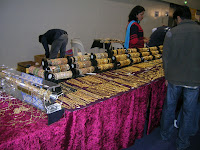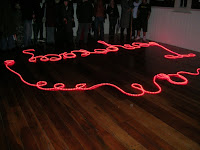












Kia ora (Hi, hello)
Yesterday (31-10-09), a group of about 100 students from Te Wananga o Aotearoa spent a day in Ruapotaka Marae as part of the course requirement. It was a very colourful and rewarding learning experience for me and i totally enjoyed the Maori culture and hospitality extended to us.
We gathered at the entrance to the Marae compound at 8.30 am and was briefed by the official of the Tikanga (Protocols) of the marae .We are not allowed to eat, and drink inside the meeting house and also not allowed to smoke within the compound surrounding the marae. I enquired and was told not to take photos inside the meeting house while the powhiri or welcoming ceremony is carried out. I was rather disappointed but have to respect the hosts.
The term marae describes a communal "plaza" area that includes a wharunei (meeting house) and a wharekai (dinning room). It provides a focus for social, culture and spiritual life for the Maori community. Going onto the marae means entering into an encounter situation, where challenges are met, and issues are debated. All new comers to the marae must be greeted formally by the tangata whenua (hosts).
There is a standard dress code for the powhiri (welcoming or ritual ceremony) where women usually wear a long black skirt and black top and men long black trousers and a shirt.
Collection of koha (gift) took place prior to the powhiri on to the marae. In the days of old, food was given as a koha, but nowadays monetary koha is the norm with no set amount of money where people can contribute what they can afford, no matter how small it may be.
We were asked to assemble and line up at the entrance (signify to the hosts that we are ready to enter the marae) with women standing in front and the men behind the women (signify that we come in peace and men as the protectors).
A kai karanga (caller) of the tangata whenua (hosts) then began to call the manuwhiri (visitors) on to the marae. This is the first voice that is heard. When the karanga (call) begins, the kai karanga (caller) of our visiting group proceeded on to the marae (we followed slowly) and responded with karanga also. When moving to be seated, the front rows of the seating were reserved for the kai korero (speakers) and the elder men and the next row for the kai waiata (singers) and elder women. The remaining seats were occupied by the rest of the adults. The group waited until the front rows were seated before sitting.
Once everyone has been seated , the whakorero (formal proceedings) commenced. The kaumatua (elder on the marae) then spoke followed by a waiata (song) sung by the kai waiata (singers) to compliment and support what the speaker has said. This is followed by our speaker and singers. The whaikorero then alternated between the tangata whenua (hosts) and the manuwhiri (visitos) kai korero (speakers). This manner of giving speeches is known as Tau-utu-utu (alternating speeches). The other variance is known as Paeke oratory style which refers to the kai korero speaking in a block rather than alternating speakers.
At the conclusion of the whaikorero the last kai korero (speaker) of our visiting group laid the koha on the floor in front of the hosts side. After the visiting group have sung their waiata and seated, a lai karanga of the tangata whenua side acknowledged the manuwhiri by way of karanga (call) for the gift. A kai korero of the tangata whenua side then moved forward to pick up the koha and acknowledged also the manuwhiri for their gift.
Following the oratory, we then move towards the hosts to greet them with the hongi (pressing of noises). The significance of the hongi is that it acknowledges a person spiritually, physically and genealogically.
After the powhiri, a kai karanga of the tangata whenua performed a karanga to let us know to make our wau to the whare kai (dinning room) to have our morning tea.Thereafer, we proceeded to attend three separate workshops on Powhiri (welcoming ceremony), Flax Weaving and Maori Songs and Haka" . For Powhiri workshop, we were divided into a small group of 5 or 6 people where we have to do a mind-mapping of the powhiri we attended earlier and a representative from each group has to give a talk on their group's findings.
Raranga Harakere or flax weaving is interesting. We were told on various varieties of flax and the things/objects which can be made from flax weaving such as piupiu (skirt), kete (bag), tipari (headband) and many others. We were taught to create flower from the flax. The blades of the harakeke (flax) plant and its tightly entwined roots epitomize its inner strength and tenacity. Harakere embodies the spiritual beliefs of Maori people symbolizes the whanau (family), hapu (sub tribe) and iwi (tribe) and evokes strong feelings of unity and togetherness. There are certain protocols or restrictions in the gathering, preparing and eventual weaving of the fibers eg "do not cut in the rain or at night", 'do not step over flax or unfinished work", "no eating or drinking while weaving" "women during their "moontime" (menstrual periods) should not go near the harakere", etc.....
The Maori song and haka were also very challenging and movement of hands and legs are an important part of the act.
For lunch, a representative of the elder blessed the food and we began to enjoy the hot hangi served to us.We were told that the ringawera started to prepare the Maori hangi since the afternoon before yesterday). After we have finished our meals, our three representatives stood up to give three separate speeches (English & Chinese) to thank the ringawera (the people who prepared the meal) and the people of the marae for their hospitality followed by songs (English & Chinese) sung by us to support our spkeakers. This brings the formalities to a close. After lunch we proceeded to the compound to do the Maori song and Haka which we learned yesterday morning during the workshop .We also took group photos and interacted among all participants and hosts. A closing ceremony was held in the marae where participants talked on their experience for the day and acknowledged the hospitality by the hosts. It ended at about 3.00 pm.
During the day, i also came across some Maori words which are similar to Malay words eg "terlinga" for ear and "tua" for old or elder. There are also other tikanga (protocols) practices on the marae like "do not sit on pillows", 'do not sit on tables", "sitting appropriately", "taking off shoes" "switching off mobile".......
Hei konei ra (Goodbye)
Please click on photo to enlarge
Posted by H T Yeoh on 1st Nov 2009 Sunday




















